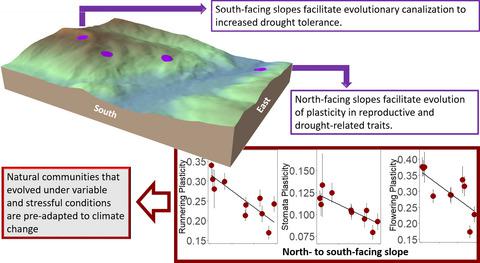Our official English website, www.x-mol.net, welcomes your feedback! (Note: you will need to create a separate account there.)
Pre‐adaptation to climate change through topography‐driven phenotypic plasticity
Journal of Ecology ( IF 5.5 ) Pub Date : 2020-01-29 , DOI: 10.1111/1365-2745.13365 Hanne De Kort 1 , Bart Panis 2 , Kenny Helsen 1 , Rolland Douzet 3 , Steven B. Janssens 4 , Olivier Honnay 1
中文翻译:

通过地形驱动的表型可塑性预先适应气候变化
更新日期:2020-01-29
Journal of Ecology ( IF 5.5 ) Pub Date : 2020-01-29 , DOI: 10.1111/1365-2745.13365 Hanne De Kort 1 , Bart Panis 2 , Kenny Helsen 1 , Rolland Douzet 3 , Steven B. Janssens 4 , Olivier Honnay 1
Affiliation

|
- Climate change will increase the level of drought stress experienced by plant communities, but the spatial distribution of projected changes in dryness remains highly uncertain. Species can, to some extent, deal with climate uncertainty through natural variation in adaptive responses to environmental heterogeneity and predictability. Biodiversity conservation could thus target populations pre‐adapted to climatic heterogeneity to anticipate climate uncertainty. Disentangling adaptive evolution of trait means versus trait plasticity, however, requires a sampling design with genetic replicates grown under distinct environmental conditions.
- Here, we applied three soil moisture treatments to genetic replicates of Fragaria vesca plants raised from seeds that were sampled in distinct topographical settings, to study adaptive trait and plasticity divergence in response to drought.
- We demonstrate that various plant traits evolved along distinct topographical gradients. Populations on south‐exposed slopes, for example, retained high levels of both flowering and runner formation under drought stress, while north‐faced populations hardly flowered under reduced soil moisture levels. Aspect but not elevation was found to coincide with variation in plant traits, suggesting that microenvironmental variation rather than general clines in elevation drive evolution in mountainous landscapes. Our results also indicate that traits and their plasticity can evolve independently in response to distinct topographical stressors.
- Synthesis . We conclude that heterogeneous landscapes (a) harbour micro‐refugia of adaptive genetic diversity that protect natural populations against environmental change, and (b) represent invaluable sources of quantitative genetic variation that could support conservation where climate projections are inconclusive.
中文翻译:

通过地形驱动的表型可塑性预先适应气候变化
- 气候变化将增加植物群落遭受干旱胁迫的程度,但预计干燥度变化的空间分布仍然高度不确定。物种可以在一定程度上通过对环境异质性和可预测性的适应性响应中的自然变化来应对气候不确定性。因此,生物多样性保护可以针对预先适应气候异质性的人群,以预测气候不确定性。区分特征手段与特征可塑性的适应性进化,然而,需要进行采样设计,并在不同的环境条件下生长出基因复制品。
- 在这里,我们将三种土壤水分处理方法应用于草莓种子的遗传复制品,该种子从在不同地形条件下采样的种子培育而成,以研究干旱适应性状和可塑性差异。
- 我们证明了各种植物性状沿着独特的地形梯度演化。例如,南坡的种群在干旱胁迫下保持较高水平的开花和流道形成,而北坡的种群在土壤湿度降低的情况下几乎不开花。发现坡度而不是海拔与植物性状的变化一致,这表明海拔的微环境变化而不是一般的上升趋势驱动了山区景观的演变。我们的结果还表明,性状及其可塑性可以响应于不同的地形应力源而独立发展。
- 综合。我们得出的结论是,异质景观(a)具有保护自然种群免受环境变化影响的适应性遗传多样性微区系(b)代表了定量的遗传变异的宝贵来源,可以在气候预测尚无定论的情况下支持自然保护。


























 京公网安备 11010802027423号
京公网安备 11010802027423号